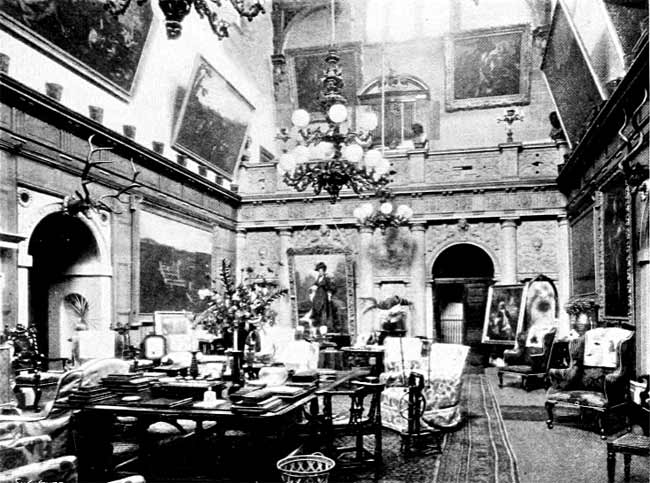However questionable this top may appear, in point of architectural fitness, there can be no question as to the dignity and grandeur imparted to the house thereby; as also to its value in the landscape; and old Hardwick and modern Mentmore both lose by their lower status!
The top room, modernly styled the Prospect Room because of the fine views embraced by its surrounding windows, is virtually useless, save as a sort of museum: the only approach to—except, indeed, a small turret stair from the lower leads— is by a sort of lighthouse-like winding stone staircase.
"Bedlam"—so called from its being the bed-place of retainers, brought of yore in large numbers by dignified guests— is of the size of the Great Hall, but lower.
At present it contains books; old garments from Tudor days downwards (though the pick of the collection has been lent for many years to the Nottingham Museum); State beds, unfortunately dismantled; ancient Peruvian pottery, and relics of the natural philosopher, Francis Willoughby, the distinguished father of our historian, her Grace of Chandos.
It was the sixth Lord Middleton who, alas! in 1834, "took down the decayed wainscot in the Hall, and in my room, covered the walls with mastic, and painted them." He employed Sir Geoffrey Wyatt ("the Destroyer") to more or less remodel the interior of the house, and though, doubtless, general comfort was increased, yet terrible breaches of taste were committed in the most costly fashion. The lattice windows, the old stair balustrades, etc., all vanished.
This sixth Lord Middleton, Henry, was a man of wealth, and of most independent and resolute character; and the accounts of his sales and purchases of land and other dealings in £ s. d. would cover many pages. Among his lavish expenditures he built the big Lenton Lodge and the Camellia House, at a cost each of something like £10,000. Wyatt added the present servants' hall, housekeeper's room, etc., and not at all to the detriment of the architectural effect.
But to return to the building of Wollaton. It is said the niches on the facades of the house were intended to hold statuettes, but tradition gives it that the ship bearing these from Italy was wrecked, and its cargo lost. Some of the busts in the round niches are of later insertion, for surely Charles I. is there! The enrichment to the already wealthy decore by those sunken images would have been wondrous.

The Great Hall, Wollaton, with screen and minstrel's gallery.
Among Wyatt's changes must have been closing in with doors the tine stone screen supporting the "Minstrels' Gallerey," over which one loves to throw, Paolo Veronese fashion, heavy draperies of crimson velvet! The Hall had included the present outside passage under the Gallery. The Hall measurements may have interest:—
| Length, including screen and gallery | 61 ft. | 10½in. |
| " up to screen (as now) | 50" | 7 " |
| Width | 50 " | 1 " |
| Height | 50 " | 9 " |
| and the top, "Bedlam"— | ||
| Length | 61 ft. | 2 in. |
| Width | 29 " | 4 " |
| Height | 22'' | 6 " |
The great charm of this Hall is that, once shut the eight doors leading into it, you are in a room private almost as a boudoir; for its only gallery, the Minstrels' [?] at one end, holding the old organ (last repaired in 1799), is not necessarily a passage. So, in summer, when you escape the glare by down-drawn screens to the high sun-blazoned windows, and sit luxuriously looking through the Saloon to its open terrace door, on the vivid greenery without, yourself cool as in a woodland; so, in winter, when coiled in the great chairs in front of a fire whose feeding coal-blocks are each a man's burden, and one of the great chandeliers lights in rich harmony and no glare the pictures, plenishing, and high heraldry of the roof,—be you one, or be you a score, you feel essentially—Homed!
In a dwelling so given up to external symmetries, and this great Hall's space, it is natural that other rooms should suffer, so there are none of any (proportionately) notable size, though the old Drawing- and Dining-rooms up-stairs (the latter temporarily converted into small closed cubicles for bachelors) are not mean apartments, and some of the bedrooms are large and lofty. But many run through each other, or have little staircases leading up to others only by making passage-rooms of the first.
The two chief staircases, north and south, have undoubtedly suffered in interest from Wyatt's improvements; as, though decorated—one, walls and ceiling, the other, ceiling only—by Verrio or Laguerre (his pupil) with painted mythology, they are quite modernised.
A young architect, Mr. Allen, counted the masks, heads, etc., occurring in the detail of sculptured decoration on the outside of the Hall. There are 32 busts, 20 full-length figures, 4 smaller figures, 14 skulls, 30 heads on ground floor, 104 on first floor, 64 on second floor: total of heads, 198. On the shields on second floor there are 16 owls' and 16 lions' heads, and on the strapwork finish to the towers there are 32 heads.
